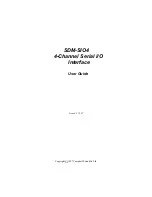
62
Rockwell Automation Publication 5069-UM003B-EN-P - January 2020
Chapter 3
Compact 5000 I/O Serial Module Features
Designing Communication for DF1 Radio Modem Protocol
When designing communication using DF1 Radio Modem protocol, you must
consider the capabilities of both the controllers and radio modems. The DF1
Radio Modem protocol can only be used with controllers that support and are
configured for this protocol.
Determining When to Use DF1 Radio Modem Protocol
If your radio modem can handle full-duplex data port buffering and radio
transmission collision avoidance, you can use peer-to-peer message initiation
capability in every node (i.e., the ladder logic in any node can trigger a MSG
instruction to any other node at any time). For messaging between nodes that are
outside of radio transmission/reception range of each other, you may use either
the Store and Forward capability of the protocol or the repeater capability of the
radios.
If your radio modem cannot handle full-duplex data port buffering and radio
transmission collision avoidance, you can still use DF1 Radio Modem protocol in
a Master/Slave configuration, with message initiation limited to one master
node. If you still require slave node message initiation, then you must use the DF1
Half-Duplex protocol.
The primary advantage of using DF1 Radio Modem protocol for radio modem
networks is in the transmission efficiency. Each read/write transaction
(command and reply) requires only one transmission by the initiator (to send the
command) and one transmission by the responder (to return the reply). The
number of transmissions is minimized, radio power is minimized, and
throughput is maximized. In contrast, DF1 Half-Duplex protocol requires five
transmissions for the DF1 Master to complete a read/write transaction with a
DF1 Slave. See
the DF1 Radio Modem protocol.
An efficiency trade-off exists in that the DF1 Radio Modem protocol does not
provide immediate feedback (ACK) to the initiator to indicate that the
responder successfully received the communications packet without error.
The Store and Forward capability of the DF1 Radio Modem protocol allows
messages between nodes that are outside of radio transmission/reception range of
each other to be routed through intermediary nodes that are within range. Each
of the intermediary nodes needs a Store and Forward table. The configuration
must indicate, based on the source and destination addresses in the message
packet, which packets to receive (store) and then rebroadcast (forward). The
following section explains how the Store and Forward function is configured.
















































